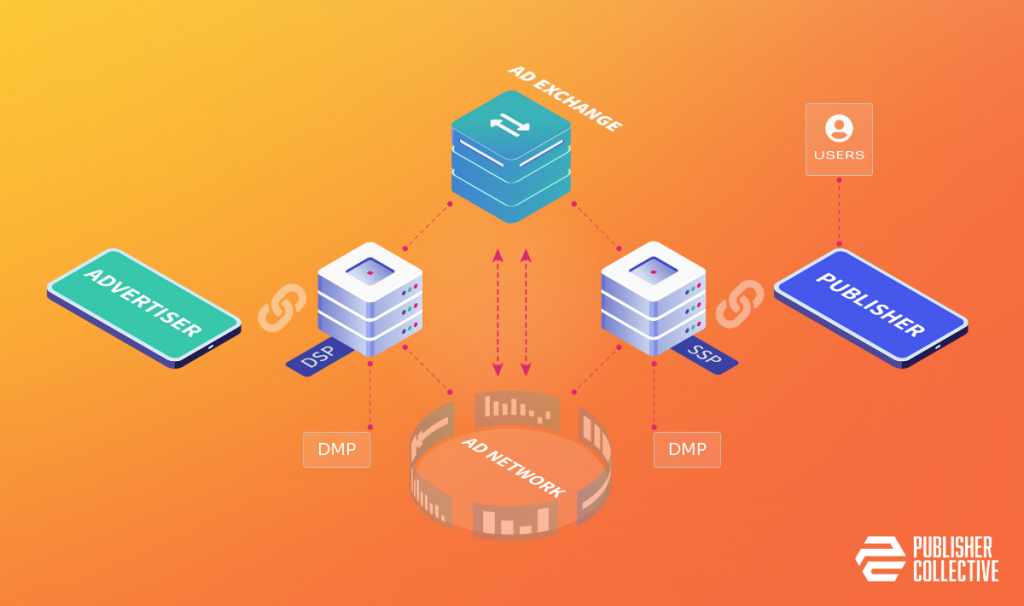What Is a Demand Side Platform? A Publisher’s Guide to DSPs

You don’t need to know how demand side platforms (DSPs) work to make money from programmatic ads. But if you’ve ever looked at a dip in revenue and thought, what changed?, there’s a good chance the answer starts with a DSP.
Demand side platforms are often seen as the advertiser’s problem, something happening in the background and far removed from your site. But they’re one of the key players deciding which ads show up, how much they pay, and whether your inventory is even considered in the first place.
Understanding the basics can help you make more sense of what’s happening behind the scenes, especially when performance shifts for no obvious reason.
If you’re new to programmatic advertising or want a broader overview of how all the pieces fit together, check out our Ad Tech 101 guide.
Let’s break it down from the start.
What Is a Demand Side Platform?
A demand side platform (DSP) is a tool that advertisers use to buy digital ad space through automated, real-time auctions. Instead of reaching out to individual websites one by one, a DSP lets advertisers bid on thousands of impressions across many sites at once. The goal is to find the right audience at the right time, all while staying within budget.
From the publisher’s perspective, DSPs are the buyer on the other side of the auction. When someone visits your site, the ad space is offered to multiple DSPs through a Supply Side Platform (SSP) or ad exchange. Each DSP receives the bid request, evaluates it based on the advertiser’s targeting and goals, and then decides whether to place a bid and how much that bid should be.
DSPs are a key part of programmatic advertising, helping to automate what used to be manual and time-consuming media buying.
🧠 TL;DR A demand-side platform (DSP) is a tool advertisers use to automatically buy ad space across many websites in real time. It helps them target the right users, control their budget, and optimize results. As a publisher, this is the tech that powers the bidding behind the scenes every time your ad space is sold.
How Do DSPs Work?
To understand how a DSP works, it helps to zoom in on what happens the moment someone lands on your site. Behind the scenes, an auction is triggered for the available ad space.
Here’s how the process typically plays out:
- A user visits your site. Your page loads, and the ad slots send out a request for bids.
- Your SSP or ad server issues a bid request. This request includes information like the user’s location, device, browser, and basic behavioral data (if available).
- The DSP receives the bid request. It checks whether the user matches the advertiser’s targeting criteria.
- If it’s a match, the DSP calculates a bid. It considers factors like bid strategy, budget limits, frequency caps, and expected performance.
- The DSP sends back its bid. If it wins the auction, the ad is served on your page, usually within milliseconds.
This process is fully automated and repeats for every impression, helping advertisers scale their campaigns efficiently while giving publishers access to a broader pool of buyers.

DSPs vs SSPs vs Ad Exchanges: How do they work together?
Now that we’ve covered how a DSP works, let’s zoom out and look at how it fits into the larger programmatic system. DSPs don’t work alone. They rely on other platforms to connect advertisers to available ad space on your site.
Here’s how each piece fits into the puzzle:
The SSP (Supply Side Platform)
This is the platform on the publisher’s side. It manages your ad inventory and sends it out for auction. When someone visits your site, your SSP generates a bid request that includes details like the user’s device, location, and the ad slot available.
The Ad Exchange
You can think of the ad exchange as the auction house. It collects bid requests from SSPs and shares them with multiple DSPs. It acts as a middle layer that connects supply (your ad space) with demand (advertisers looking to buy impressions).
The DSP (Demand-Side Platform)
This is where the advertiser steps in. The DSP receives the bid request, checks whether it aligns with the advertiser’s targeting, and decides whether to bid. If it does, it sends back a bid along with the ad creative. The highest bid wins, and the ad is served on your site.
The entire process looks something like this:
- A user visits your site.
- Your SSP sends a bid request to an ad exchange.
- The exchange forwards the request to multiple DSPs.
- Each DSP evaluates the opportunity and may place a bid.
- The winning bid is selected, and the ad is delivered instantly.
Understanding how DSPs interact with SSPs and ad exchanges makes it easier to see how money actually moves through the system. It also helps you make more informed decisions about which partners to work with and where potential issues might arise.
Why Should Publishers Understand DSPs?
Demand-side platforms are built for advertisers, but they have a direct influence on your earnings as a publisher. Every time your ad space is auctioned, it’s DSPs that decide whether to bid, how much to offer, and which ad gets served. That means they’re closely tied to how much you earn, even if you never deal with them directly.
Here’s why it helps to understand how they work:
DSPs Influence Your Ad Revenue
DSPs follow specific targeting rules, budget limits, and bidding strategies. If something changes on the advertiser’s side, like a shift in campaign goals or spend, it can affect how often your inventory gets bids and how competitive those bids are.
Let’s say your average CPM drops unexpectedly. At first glance, it might seem like something’s wrong with your content or audience. But in reality, it could be that a major DSP adjusted its targeting criteria, started using more aggressive bid shading, or reduced its budget in your vertical. Without that context, it’s hard to figure out what’s really going on.
Advertisers Rely on DSPs (And That’s Good For You)
DSPs give advertisers more control over how and where they spend their budgets. They can fine-tune their targeting, limit how often someone sees an ad, and adjust bids in real time based on what’s performing. That level of control makes programmatic campaigns more efficient, which keeps advertisers coming back.
For publishers, that matters. The more confident advertisers feel about where their money is going, the more likely they are to include your inventory in their targeting. If your site attracts the right audience and your setup is optimized, you’re in a strong position to benefit from those smarter, better-funded campaigns.
They Affect Auction Dynamics
Not all DSPs behave the same way. Some are more active in specific verticals or regions, while others use advanced techniques like bid shading to control costs. If your monetization setup includes a diverse mix of DSPs, you’ll likely see stronger competition and more consistent results.
They Help Determine Which Ads Appear
The ad that wins the auction comes from a DSP. That means the quality, format, and load speed of the ad depends in part on how the DSP is set up. Some prioritize lightweight display banners, while others may favor high-impact video or interactive formats.
By understanding how DSPs operate, you’ll be in a better position to evaluate your monetization partner and troubleshoot any changes in performance or user experience.
How Publisher Collective Works with DSPs
You probably don’t spend your day thinking about demand side platforms. And honestly, you shouldn’t have to. Our job is to make sure the right DSPs have access to your inventory, that they’re competing properly, and that nothing strange is happening behind the scenes.
We work with a wide mix of DSPs and track how they perform across different verticals, geographies, and formats. If one starts pulling back or playing games with bid shading, we’ll spot it. If another is delivering strong results for sites like yours, we’ll make sure your setup takes advantage of it.
This isn’t about stuffing your stack with more partners. It’s about knowing which ones are worth your time and which ones just clog up the auction with low-quality bids. We keep things lean and competitive, so your site gets real value from the demand side.
We also take care of the messy parts, like integration bugs, broken reporting, and privacy updates that seem to change every few months. DSPs are getting more complicated, but your monetization setup doesn’t have to.
Want us to take a look at how things are running on your site? Get in touch and we’ll walk you through it.
Related Ad Tech Terms You Might Come Across
As you dig into the world of DSPs, you’ll probably run into a few other ad tech terms. Some are directly related, while others are just commonly mentioned in the same context. Here’s a quick explainer to help make sense of the jargon.
Real-Time Bidding (RTB)
RTB is the process that powers most programmatic auctions. It’s what allows DSPs to evaluate and bid on impressions in the time it takes for a page to load. Every impression is treated as a mini auction, with multiple DSPs submitting bids based on their targeting and budgets.
Data Management Platform (DMP)
A DMP is used by advertisers to collect and organize data about users. This data is often used to improve targeting on DSPs. For example, an advertiser might use a DMP to identify users interested in travel, then target them through a DSP across multiple sites.
Bid Shading
Bid shading is a strategy DSPs use to avoid overpaying in first-price auctions. It allows the DSP to calculate a bid that’s likely to win without going too high. While it helps advertisers save money, it can reduce what publishers earn if bids are consistently lowered.
User ID / Identity Solutions
As third-party cookies are phased out, DSPs are starting to rely on identity solutions to recognize users across sites. These can include first-party data, email hashes, or alternative ID frameworks. Strong identity signals can improve match rates and lead to better bids.
FAQ
What does a demand side platform do?
A demand-side platform (DSP) helps advertisers buy ad space across many websites in real time. It allows them to set targeting, control budgets, and bid automatically through programmatic auctions.
What is an example of a DSP?
Some of the most well-known DSPs include Google Display & Video 360 (DV360), The Trade Desk, Amazon DSP, and MediaMath. Each one gives advertisers access to different types of inventory and targeting tools.
How do demand side platforms make money?
DSPs typically charge advertisers a percentage of ad spend. Some also offer tiered services or charge tech fees based on usage, data integrations, or advanced features.
Is Google Ads a DSP?
Google Ads is not really a DSP, but a broader ad platform for search and display. Google’s actual DSP for programmatic campaigns is called Display & Video 360 (DV360), which is part of the Google Marketing Platform.

